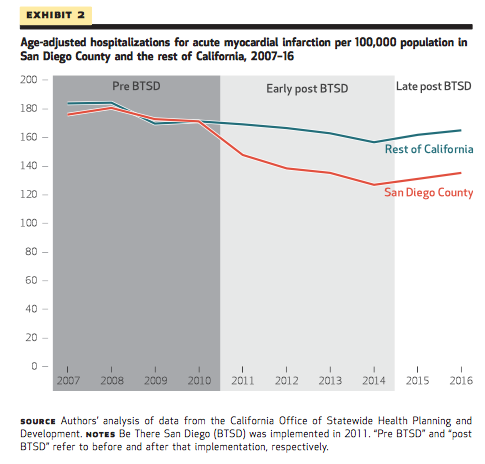There's something going on in the San Diego area – and it centers around a whole lot more people lowering their risk for a heart attack.
Amid this good news, health experts are still trying to define why exactly this is the case. But the facts are pointing towards a patient data-sharing movement that began in 2011, one which coincides with a startling, 22 percent decrease in local heart attack hospitalizations beginning that year and extending through 2016.
Seven years ago a local organization, Be There San Diego, launched an initiative to battle heart disease among residents of San Diego County by coordinating the efforts of doctors and other health experts to care for those who could be vulnerable. The idea was to actively target patients – utilizing follow-up appointments and making more frequent contact – when factors such as blood pressure, blood sugar levels and cholesterol levels showed that additional intervention was warranted.
Monthly meetings were held among doctors and community health workers, gatherings that identified which patients were in need of attention to stay on top of their potentially-threatening conditions.
“We organized our community in a way that we were goal-oriented to reduce heart attacks and strokes,” said the study's co-author and cardiologist Dr. Anthony DeMaria, a principal force with Be There San Diego, as quoted by the San Diego Union-Tribune. "That orientation allowed us to share the data with each other that’s necessary to identify the patients who are most at risk and make sure they are aggressively treated.”
The work of the organization, known also as BTSD, centered on "four domains: clinical, community, community-clinical linkages, and the health care ecosystem," the study's authors wrote in their paper, which was published last week in the September edition of Health Affairs.
The effort included " the expanded use of health coaches within the overall physician and staff patient care teams;" ... launching "a faith-based partnership focused on engaging nineteen African American churches in Southeastern San Diego, a predominantly African American community of low socioeconomic status;" ... and "linkages between clinicians and the community through partnerships with pharmacists and community health workers."
The health coaches, who worked directly with the highest-risk patients, were paid for with a federal grant. And even when the grant expired, several medical groups decided to keep funding the coaches because their intervention actually saved greater costs in the long run.
Researchers soon learned that heart attack hospitalizations plunged by the thousands over that six-year period and that San Diego County's 22 percent reduction far outpaced the state's 8 percent drop over that same period.
 "Before 2011 rates of hospitalization for heart attacks were about the same in San Diego County as they were in the rest of California," However, following BTSD's formation, "Nearly four thousand [acute myocardial infarction] AMI hospitalizations were avoided and $86 million saved during the first six years of the collaborative. Reductions occurred and were sustained across all adult age groups, in contrast to the rest of the state."
"Before 2011 rates of hospitalization for heart attacks were about the same in San Diego County as they were in the rest of California," However, following BTSD's formation, "Nearly four thousand [acute myocardial infarction] AMI hospitalizations were avoided and $86 million saved during the first six years of the collaborative. Reductions occurred and were sustained across all adult age groups, in contrast to the rest of the state."
Since the study, titled, "One In Five Fewer Heart Attacks: Impact, Savings, And Sustainability In San Diego County Collaborative," was observational, there's no conclusive proof that BTSD's program was the definitive explanation for this formidable success. However, for a county made up of 3.3 million residents, the correlation is too significant to dismiss.
“Unless there was some other cardiovascular program in operation with the same sort of scope," said Dr. Deepak Bhatt, a cardiovascular program director at Harvard Medical School, told the Union-Tribune, "I tend to believe there is something here.”




